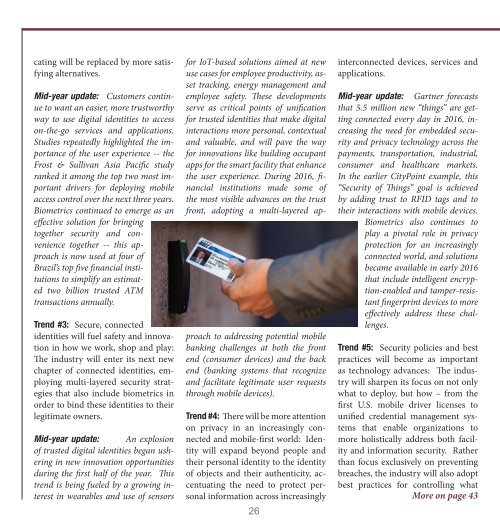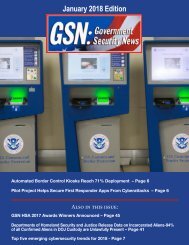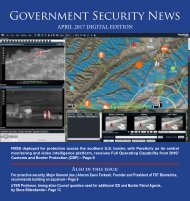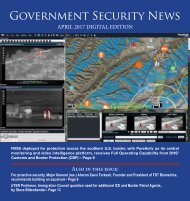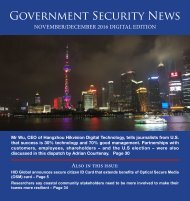Government Security News August Digital Edition
You also want an ePaper? Increase the reach of your titles
YUMPU automatically turns print PDFs into web optimized ePapers that Google loves.
cating will be replaced by more satisfying<br />
alternatives.<br />
Mid-year update: Customers continue<br />
to want an easier, more trustworthy<br />
way to use digital identities to access<br />
on-the-go services and applications.<br />
Studies repeatedly highlighted the importance<br />
of the user experience -- the<br />
Frost & Sullivan Asia Pacific study<br />
ranked it among the top two most important<br />
drivers for deploying mobile<br />
access control over the next three years.<br />
Biometrics continued to emerge as an<br />
effective solution for bringing<br />
together security and convenience<br />
together -- this approach<br />
is now used at four of<br />
Brazil’s top five financial institutions<br />
to simplify an estimated<br />
two billion trusted ATM<br />
transactions annually.<br />
Trend #3: Secure, connected<br />
identities will fuel safety and innovation<br />
in how we work, shop and play:<br />
The industry will enter its next new<br />
chapter of connected identities, employing<br />
multi-layered security strategies<br />
that also include biometrics in<br />
order to bind these identities to their<br />
legitimate owners.<br />
Mid-year update: An explosion<br />
of trusted digital identities began ushering<br />
in new innovation opportunities<br />
during the first half of the year. This<br />
trend is being fueled by a growing interest<br />
in wearables and use of sensors<br />
for IoT-based solutions aimed at new<br />
use cases for employee productivity, asset<br />
tracking, energy management and<br />
employee safety. These developments<br />
serve as critical points of unification<br />
for trusted identities that make digital<br />
interactions more personal, contextual<br />
and valuable, and will pave the way<br />
for innovations like building occupant<br />
apps for the smart facility that enhance<br />
the user experience. During 2016, financial<br />
institutions made some of<br />
the most visible advances on the trust<br />
front, adopting a multi-layered approach<br />
to addressing potential mobile<br />
banking challenges at both the front<br />
end (consumer devices) and the back<br />
end (banking systems that recognize<br />
and facilitate legitimate user requests<br />
through mobile devices).<br />
Trend #4: There will be more attention<br />
on privacy in an increasingly connected<br />
and mobile-first world: Identity<br />
will expand beyond people and<br />
their personal identity to the identity<br />
of objects and their authenticity, accentuating<br />
the need to protect personal<br />
information across increasingly<br />
26<br />
interconnected devices, services and<br />
applications.<br />
Mid-year update: Gartner forecasts<br />
that 5.5 million new “things” are getting<br />
connected every day in 2016, increasing<br />
the need for embedded security<br />
and privacy technology across the<br />
payments, transportation, industrial,<br />
consumer and healthcare markets.<br />
In the earlier CityPoint example, this<br />
“<strong>Security</strong> of Things” goal is achieved<br />
by adding trust to RFID tags and to<br />
their interactions with mobile devices.<br />
Biometrics also continues to<br />
play a pivotal role in privacy<br />
protection for an increasingly<br />
connected world, and solutions<br />
became available in early 2016<br />
that include intelligent encryption-enabled<br />
and tamper-resistant<br />
fingerprint devices to more<br />
effectively address these challenges.<br />
Trend #5: <strong>Security</strong> policies and best<br />
practices will become as important<br />
as technology advances: The industry<br />
will sharpen its focus on not only<br />
what to deploy, but how – from the<br />
first U.S. mobile driver licenses to<br />
unified credential management systems<br />
that enable organizations to<br />
more holistically address both facility<br />
and information security. Rather<br />
than focus exclusively on preventing<br />
breaches, the industry will also adopt<br />
best practices for controlling what<br />
More on page 43


